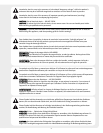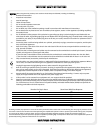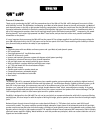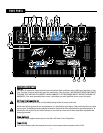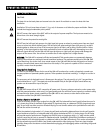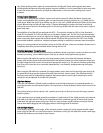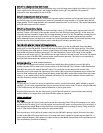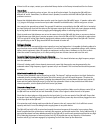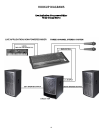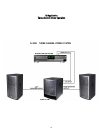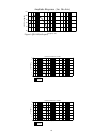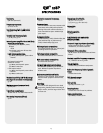
10
If there is still no output, contact your authorized Peavey dealer or the Peavey International Service Center.
HHuumm oorr BBuuzzzz
If the QW 118P is producing a hum or buzz, this can be AC outlet-related. Try plugging the QW 118P into a
different AC outlet. Sometimes, if a different circuit (breaker) is used for the mixer and the QW 118P, hum
problems can occur.
Ensure that shielded cables have been used to route the signal to the QW 118P’s inputs. If speaker cables with
1/4" plugs or XLR plugs are used as an input cable instead of a shielded cable, it will be very prone to hum.
Hum may also be ground loop-related. Two ground lift switches are provided on the QW 118P. One is located at
the input jack group (10a) and the other at the high-pass output jacks (10b). Check any input changes carefully
by turning down the volume control, plugging and unplugging cables or switching the ground lifts.
Check to make sure light dimmers are not on the same circuit as the QW 118P, the mixer or any source devices.
If light dimmers are used, then it may be necessary to turn them full ON or full OFF to eliminate or reduce hum.
This is a typical AC wiring/light dimmer interference problem, and not a design flaw of the QW 118P. The third
wire ground plug on the AC plug should NEVER be removed or broken off.
RRaattttlliinngg oorr BBuuzzzziinngg
The QW 118P has an extremely high output capacity at very low frequencies. It is capable of vibrating objects in
any room that are not solidly affixed or mounted. It can excite light fixtures, suspended ceilings, racks, shelves,
tables, chairs, equipment cases, lift handles on equipment, casters, doors, windows, etc. Be sure to check
where the sound is coming from, as it is likely coming from one of these sources and not of the unit.
EExxcceessssiivvee HHiigghh FFrreeqquueennccyy OOuuttppuutt ffrroomm tthhee SSuubbwwooooffeerr
Ensure the Mono button (5d) is switched to the ON position. This should eliminate any high frequency output
from the subwoofer.
If the unit is being used in three-channel stereo mode, some high frequencies may be generated by the
subwoofer when a high frequency signal is present only in one channel. This is normal and should not present
a problem..
MMaallee VVooccaallss SSoouunndd MMuuddddyy oorr BBoooommyy
The level of the subwoofer may be turned up too high. The kosmos
®
settings may be set too high. Reduce the
subwoofer level by turning down the Quake/Sub Level control (7a) until the sound improves. To reduce the
amount of kosmos processing without changing the subwoofer level, turn the Master System level control (6)
down and the Quake/Sub level control (7a) up until the subwoofer is back at the previous level. With three-
channel operation, turn the Quake/Sub Level control (7a) down.
DDiissttoorrtteedd oorr FFuuzzzzyy SSoouunndd
First, ensure the mixer (signal source) is not clipping or being overdriven. Make sure the Volume control (6) on
the QW 118P has not been set too low. Remember, it takes a lot of signal to drive the unit to full power.
Check that the input plugs are fully seated in the input jacks (5) on the rear panel of the QW 118P. Ensure that
the proper inputs are being used (5) for line-level signals and that a power amp has not been plugged into one
of the input jacks of the QW 118P.
If an extension cord is being used to provide the AC power to the unit, ensure that it is of sufficient current
capacity and that it is not also being used to supply power to any other device.
The QW 118P has built-in EQ to extend and smooth the natural response of the woofer in any system. Bass
boost is applied and the system has a nominally flat response, and should require little, if any, additional EQ. If
excessive bass boost has been added externally to the QW 118P, it could cause premature overload at very high
SPLs. Reducing the amount of external (mixer, rack EQ) EQ should clear up any distortion. If the kosmos
function switch (7c) has been engaged, try bypassing to see if that clears up the ditstortion.



